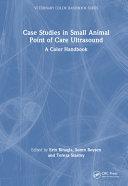Case Studies in Small Animal Point of Care Ultrasound: A Color Handbook (Veterinary Color Handbook Series) 1st Edition

Tato ilustrovaná praktická příručka pokrývá mnoho aspektů ultrazvukového vyšetření u malých zvířat (Point of Care Ultrasound:. dále jen POCUS) za využití klinických případů běžně pozorovaných v praxi. Podrobně popisuje specifické ultrazvukové techniky, názory, interpretace, úskalí a mezery ve znalostech, přičemž zdůrazňuje užitečnost počátečního a opakovaného ultrazvuku pro diagnostické účely. Kniha je rozdělená do sedmi oddílů, pokrývá ultrazvuk pleurálního prostoru a plic, srdce a břicha, stejně jako index kolapsibility kaudální žíly (CVC-CI), různé a pokročilé případy.
Tato příručka byla vytvořena předními autoritami v oboru, kde se uznávají silné stránky POCUS ve screeningu a monitorování. Zároveň zdůrazňuje omezení jeho použití jako jediného diagnostického nástroje. Autoři se zaměřují na často kladené otázky při aplikaci do klinické praxe a přistupují k veterinárnímu POCUSu s binárními otázkami, u kterých bylo prokázáno, že snižuje chyby v lidských POCUS.
Tato plnobarevná příručka je ideální referencí pro pracoviště zabývající se malými zvířaty, smíšené praxe, včetně praktických veterinárních lékařů, pohotovostních veterinárních lékařů, stážistů, rezidentů a studentů veterinární medicíny.
Autor: Erin Binagia (Editor), Soren Boysen (Editor), Tereza Stastny (Editor)
| Nakladatel | Taylor & Francis |
|---|---|
| ISBN | 9781032566566 |
| Vydání | 2023 |
| Vazba | pevná |
| Počet stran | 340 |
This illustrated practical guide covers the many facets of small animal point of care ultrasound (POCUS) using clinical cases commonly seen in practice. It details specific point of care ultrasound techniques, views, interpretations, pitfalls and knowledge gaps, highlighting the utility initial and serial point of care ultrasound for both diagnostic and patient management purposes. Divided into seven sections, the book covers ultrasound of the pleural space and lungs, heart and abdomen, as well as the Caudal Vena Cava Collapsibility Index (CVC-CI), miscellaneous and advanced cases.
Authored by leading authorities in the field, this guide recognizes the strengths of POCUS in screening and monitoring while also highlighting the limitations of using it as a sole diagnostic tool. Focusing on commonly asked questions and applications, the authors take a binary question approach to veterinary POCUS, which has been shown to decrease errors in human POCUS.
This full-colour handbook is the ideal reference for small animal and mixed practitioners, including general veterinary practitioners, emergency veterinarians, interns, residents and veterinary students.
Dr. Erin Binagia received her DVM degree from Texas A&M in 2015. She then completed an Emergency-focused Rotating Small Animal internship at what is now Arizona Veterinary Emergency and Critical Care Center in Gilbert, Arizona and stayed as an emergency veterinarian the following year. She completed her residency training in Emergency and Critical Care at Michigan State University and passed her ACVECC board exam in 2020. Since finishing residency, she moved back to Texas and has been working as a locum criticalist at multiple hospitals in Texas and Arizona and an online consultant. She is also currently an adjunct professor at Texas A&M University. Her favorite part of veterinary medicine is teaching students, interns, and residents, and her clinical interests include anaphylaxis, toxicities, sepsis, tremor disorders, and tetanus. When not working she usually enjoys running and soccer, but lately has been spending quality time with her dogs, cats, and her brand new baby girl, Eloise.
Søren obtained his DVM from the Western College of Veterinary Medicine (WCVM) in Canada, completed an internship at the Atlantic Veterinary College (AVC) in Canada, and a Residency in Small Animal Emergency and Critical Care at Tufts University in Massachusetts. He became a Diplomate of the American College of Veterinary Emergency and Critical Care (ACVECC) in 2003. Former chief of veterinary ECC at the University of Montreal (2003-2008) he helped establish veterinary ECC in the province of Quebec. In January 2009 Søren accepted a position at the University of Calgary to help with curriculum development for the newly formed college of Veterinary Medicine, where he is currently employed as a Full Professor in Small Animal Emergency and Critical Care. A recipient of numerous teaching, research, and speaker excellence awards, he has become an internationally recognized educator. A founding member of the veterinary emergency and critical care ultrasound (VECCUS) group he continues the promotion and education of veterinary ECC and point-of-care ultrasound (POCUS) globally through his numerous contributions to research, book chapters, journal publications, and work with various ACVECC, ECVECC, VECCS, ECVECC, and VetCOT committees. With the help of many great colleagues from Tufts and around the world, he co-developed the small animal FAST exam in 1999, followed by abdominal POCUS, and pleural space and lung (PLUS) exams, and continues to pioneer novel ultrasound training techniques and workshops for non-specialist practitioners. Along with POCUS, his research interests include veterinary education/simulation, hemorrhage, coagulation, resuscitation, and perfusion.
Dr. Tereza Stastny was born in the Czech Republic and grew up in Calgary, AB, Canada. She attended the University of Calgary earning her Doctor of Veterinary Medicine degree. Dr. Stastny completed a rotating internship at Texas A&M University and completed an emergency and critical care residency at Michigan State University. Dr. Stastny has a keen interest in respiratory physiology and mechanical ventilation, extracorporeal therapies, cardiac emergencies, and veterinary point-of-care ultrasound. She is passionate about teaching veterinary students and lecturing at conferences. She is currently the internship director at Arizona Veterinary Emergency and Critical Care Centre (AVECCC) and Arizona Regional Intensive Care Specialty & Emergency Veterinary Center (ARISE), and is heavily involved in AVECCC's residency training program. Outside of veterinary medicine, Dr. Stastny enjoys trail running, traveling, hiking, and coaching youth soccer.